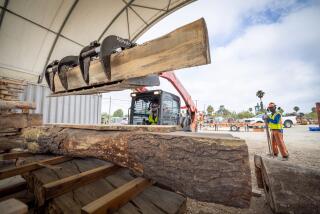Don’t Let Those Falling Leaves Go to Waste
Fall is an American season. In the rest of the English-speaking world, summer is followed by autumn. The Old World term comes from the Latin autumnus , which means “third season of the year.” However, the United States being such a woodsy place and its third season being one of great leaf-falls, somewhere along the line, the American autumn became “fall.”
Though our name for the season is poignant, our approach to it is pragmatic. After those flame-colored leaves flutter to the ground, we no longer see them as an elegy to summer. They become garden waste. We shake off our wistfulness, fire up our leaf blowers and get out our bins.
In some states, homeowners still put leaves in big black bags, and throw them away, as if they were trash. This pains Harry Hoitink, a soil specialist at Ohio State University and master of a composting Web site with a “Don’t Bag It” campaign. Hoitink is so revered in composting circles that plant pathologists at UC Riverside insisted on referring inquiries to the expert’s expert. For the last 25 years, he has been one of the leaders of a little-sung American success story.
In the 1970s, environmentalists managed to detect lead in our garden waste and from there trace it to urban traffic, he says. This discovery prompted lead’s removal from gasoline. Once the chemical profile of our garden waste improved, we then improved it from what Hoitink calls a “foreign materials point of view.” This means we got better at keeping plastic bags, bottles and the various spent things that end up in gutters out of the leaf mix.
Not only do we now make a pretty good quality of urban compost, says Hoitink, we do it in volume. At last count, he says, Americans recycled 38 million tons of green waste a year. To put that in perspective, Hoitink, a Dutchman adds, “The European countries in total only do 8 million.” (The U.S. and Europe contain roughly the same amount of land.)
Angelenos are especially good at recycling garden waste. Every bit of the 2,000 pounds of grass and leaves that are collected from our residential green bins every day gets recycled, says Enrique Zaldivar, a senior engineer with the Los Angeles Bureau of Sanitation.
About a fifth of it is composted by the city, then supplied as mulch to public parks and left at recycling centers for anyone with a sack to carry it away at no cost. But it cannot be described as “free,” warns Zaldivar. “Processing green waste is not inexpensive,” he says. “It costs us an average of $30 per ton.”
Once garden waste is picked up, most of it goes to professional composting companies, which might mix it with nitrogen-rich stuff such as zoo manure and “biosolids” from the sewage system, says Zaldivar. This fertile mix is then sold back to consumers at garden centers for anywhere from $1 to $3 a bag.
So, as it stands, we Angelenos are environmentally aware, but financially a bit goofy. We are paying city government to take green waste away, then paying garden centers to sell it back to us. Meanwhile, trees keep showering us with leaves in a vain attempt to give us a top-quality soil conditioner for free.
Different trees do this at different times and rates. The evergreen and semi-deciduous trees shed discreetly. As a rule, the leaves and needles from these--pines, western oaks, acacias, eucalypti, citrus trees, avocados and magnolias--are best left beneath the trees that shed them as a kind of self-replenishing mulch. If someone comes along trying to poach your calcium and magnesium-rich California live oak leaves, see them off with a rake.
The deciduous trees are the drama queens. Every autumn, their leaves suddenly flame and drop. In California, these will include stone-fruit trees such as apricots, peaches and plums. Plane trees also drop a load, along with liquidambar, sycamores, and California buckeyes. Their histrionics require a leaf-management plan. A gardener wishing to conserve doesn’t necessarily have to compost (composting is a chemical process in which organic matter is decayed by bacteria, and rendered odorless and rich in nutrients). Leaves can also be rotted in a litter pile.
Rotted leaves, a sort of earthy jumble called “leaf mold,” makes a good mulch cover to prevent water evaporation, or, dug in, can be a terrific soil conditioner. Los Angeles-born soil scientist John Reganold, on staff at Washington State University in Pullman, is careful to stress that conditioners are not fertilizers. Leaf mold, or humus, he says, loosens “tight” clay soils to improve water absorption and fills out “sieve-like” sandy soil to improve retention.
Getting leaves to rot isn’t complicated. You put them in a pile and leave them there. If the newly raked leaves are riotously fluffy, drench them with the hose. They will dampen down, and speedily decompose after the winter rains.
If you put the rotted leaf mold or the freshly raked autumn leaves through a composting process, you’ll have not just a conditioner, but a nutritious soil amendment.
To set up a compost operation, Hoitink recommends piling garden waste in a wire cage with an open top, far enough from your home that it won’t amount to a pre-dinner snack for termites, with your house as the main course. Starting with bed of sticks 3 to 4 inches high, which allows air flow underneath, he recommends setting out 6 to 8 inches of leaves, grass and/or kitchen cuttings, dampening the pile if it’s dry, adding an inch of soil, then as an optional step, a couple inches of composted manure. One can then layer this with anything that rots and is wholesome.
He gives these trouble-shooting tips: If your compost stinks, it will need turning. If it’s dry, it will need wetting. If it’s too cold and not “cooking” or heating to a good temperature for decomposition, it will need manure and or grass clippings. The most important rules of rotting dictate that foods which putrefy--such as meat and milk products and pet feces--should be kept out of the mix.
Purists will argue about what kind of manure to use. Manure connoisseurs prefer chicken waste to steer because of its lower salt content. But because either sort of manure is being diluted with so much green waste in compost, says Stuart Pettygrove, a soil guy at UC Davis, this is not the time to be persnickety. (More useful to the consumer is the advice to have the manure delivered. Its odor can hang around in your car longer, harder and a lot less pleasantly than wet dog smell.)
Gardeners who still want to give their leaves and green waste to the city cannot be blamed. Los Angeles does a good job recycling it. And soil huggers can be a sanctimonious lot. But what seems like self-righteousness is really just a case of learning to love fall. For composters, America’s third season is a time of bounty, bearing the promise of sweet new earth.
* The Los Angeles Bureau of Sanitation gives free composting courses and sells composting bins for about $20, a quarter of the commercial cost. For information, call (888)-CleanLA or go to https://www.lacity.org.
* The California Integrated Waste Management Board Web site has hot links to master composter programs throughout the state, along with comprehensive listings of recycling centers where free mulch is distributed: https://www.ciwmb.ca.gov
* Harry Hoitink’s composting guide is available on the Internet at https://ohioline.ag.ohio-state.edu/hyg-fact/1000/1189.html
* Recommended for tree spotters: “A Natural History of Western Trees” by Donald Culross Peattie (Houghton Mifflin; $21)
*** UNPUBLISHED NOTE ***
This story has been edited to reflect a correction to the original published text. The correct spelling for a certain tree type is liquidambar.
*** END NOTE ***






